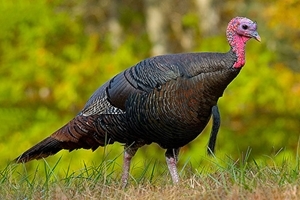Turkey
 Later this month, many of us will settle down to eat a Christmas Day feast based on a large oven-roasted turkey (Meleagris gallopavo), plus all the trimmings of course! But I wonder how many of us actually know where the turkey originated from? Don’t feel too ashamed if your knowledge on this matter is not that clear; it does appear that folk from across the world are also somewhat confused!
Later this month, many of us will settle down to eat a Christmas Day feast based on a large oven-roasted turkey (Meleagris gallopavo), plus all the trimmings of course! But I wonder how many of us actually know where the turkey originated from? Don’t feel too ashamed if your knowledge on this matter is not that clear; it does appear that folk from across the world are also somewhat confused!
The first turkeys are believed to have been brought into Britain in 1526 by a Yorkshireman named William Strickland. He managed to get hold of a few turkeys from American Indian traders on his travels and sold them for tuppence each in Bristol. He was obviously very proud of his acquisitions, as his family coat of arms haughtily shows off a large turkey as part of the family crest – one of the first portrayals of a turkey seen within Europe.
From then on, most turkeys were imported on ships into UK from America via the eastern Mediterranean, many of them arriving on Turkish merchant ships. So the British, probably without giving it much thought, assumed that these impressively large birds came from an area around Turkey and so called them turkeys!
Meanwhile, in Turkey, the Turks thought that these birds were originating from India and so called them ‘Hindi’! Another great sea-faring nation, Portugal, called the bird ‘Peru’, as they knew that they came from across the Atlantic, but their geography of the Americas was a little hazy at this time.
The expansion of Western colonialism only complicated matters further, as Malaysians call the turkey Ayam Blander (‘Dutch chicken’), whilst the Cambodians have named it Moan Barang (‘French chicken’).
So, where on earth do they ACTUALLY come from? Well, they are native to North America, along with a similar sub-species, which can be found in Mexico. Even before they were carefully selected to breed extra-large birds for the table, wild male ‘tom’ or ‘gobbler’ turkeys, as they are known in America, can reach an impressive size. The record-sized adult male wild turkey weighed in at 16.85kg (37.1lb). Here in Britain the male is called a stag and the female a hen.
Adult wild turkeys have long, reddish-yellow to grey-green legs, with feathers being blackish and dark, usually with a coppery sheen. Males have a large, featherless, reddish head and throat, with red wattles on the neck. The head also has fleshy growths called caruncles and a long, fleshy protrusion over the beak, which is called a snood.
When males become excited, the fleshy flap on the bill expands and the wattles and bare skin of the head and neck all become engorged with blood, almost concealing the eyes and bill. The tail becomes erect and fan-shaped, and the glossy bronze wings are drooped and held slightly out from the body, creating a very impressive sight.
Despite their huge size and weight, wild turkeys are not bad at flying and gliding, not only to get away from danger but also to go up to roost in trees. Their ideal habitat is open woodland or wooded pastures and scrub.
A wide range of noises are made by the male – especially in spring time. The well-known rapid ‘gobble’ noise can carry for up to a mile, to which hen birds will reply with a ‘yelp’, thereby letting the males know where they are located.
Nests are a simple, shallow dirt depressions amongst woody vegetation, in which the hen will lay a clutch of 10-14 eggs and incubate them for around 28 days. Once hatched, the chicks usually leave the nest within 12 hours, to follow along behind the hen.
Having once been an abundant bird, turkeys almost went extinct in the 1930s from loss of forest habitat and over hunting. However, recovery efforts were put in place and today the wild population is estimated to be 7 million in North and Central America.
Back in the UK, attempts to introduce the wild turkey as a gamebird in the 18th century took place. George II had a flock of a few thousand in Richmond Park, however they proved to be far too easy a prey for the local poachers, who plundered them to extinction!
It was King Edward VII who first made eating turkey fashionable at Christmas, replacing the peacock on the royal table.
By the 1720s, around 250,000 turkeys were walked from Norfolk to the London markets in small flocks of 300-1,000, to adorn the Christmas tables of the rich and wealthy. They started the slow procession in August, with birds feeding on stubble fields and stopping at specific feeding stations along the way. I’m sure it would have created quite a spectacle as they passed the villages and hamlets along the way!
You might like to test the knowledge of those around your Christmas table this year on where the turkey originates from, why it is called a turkey and, of course, on what is a snood, caruncle, tom and stag!
Happy Christmas!
Peter Thompson
Advisory